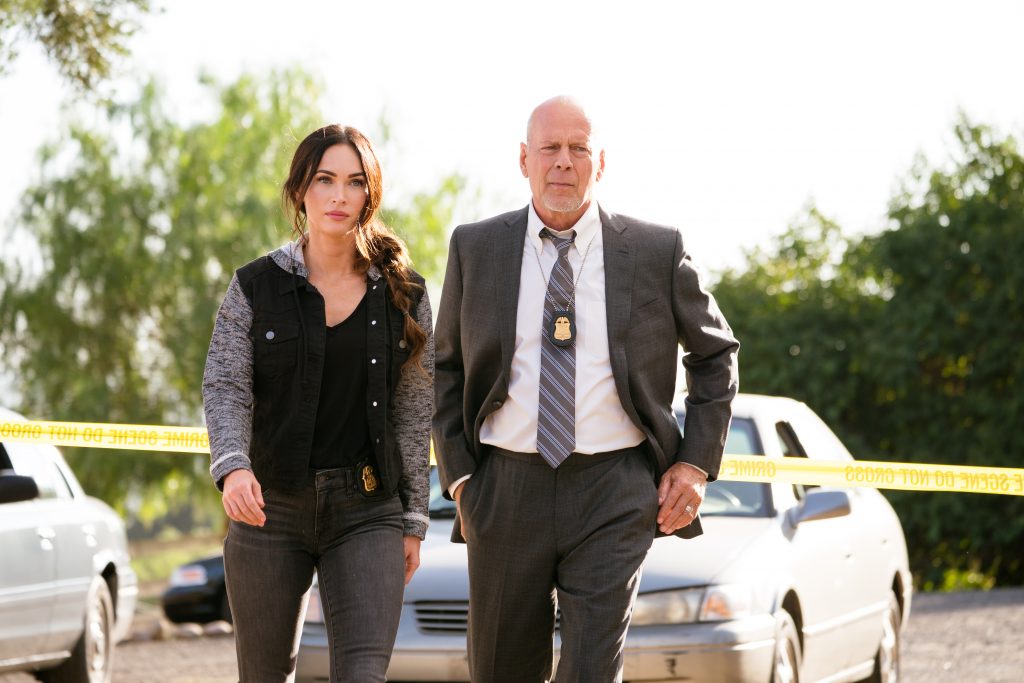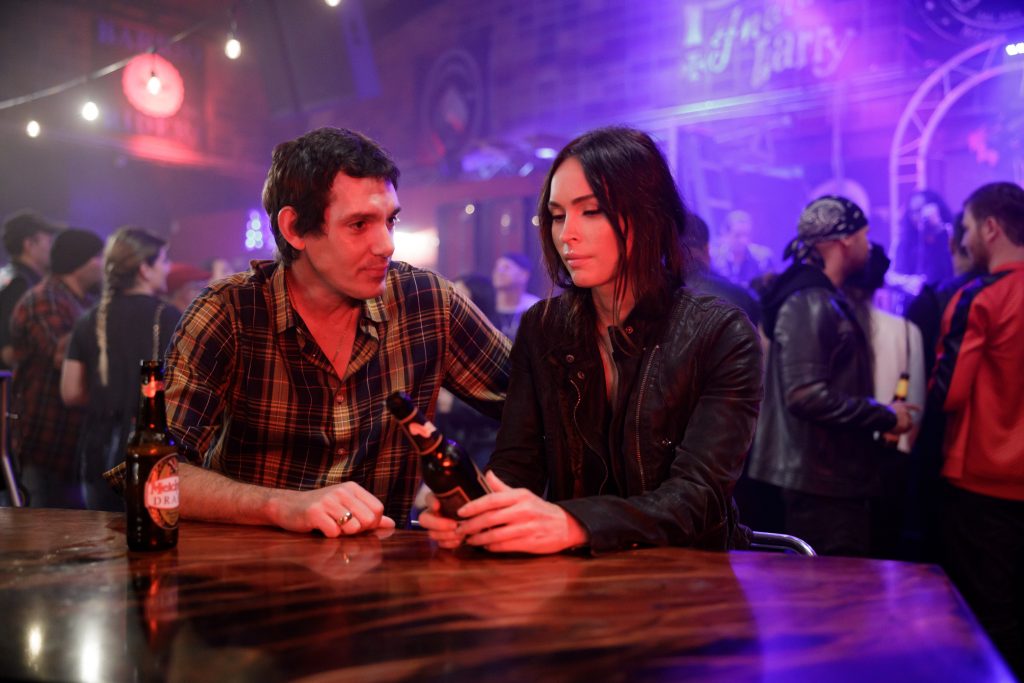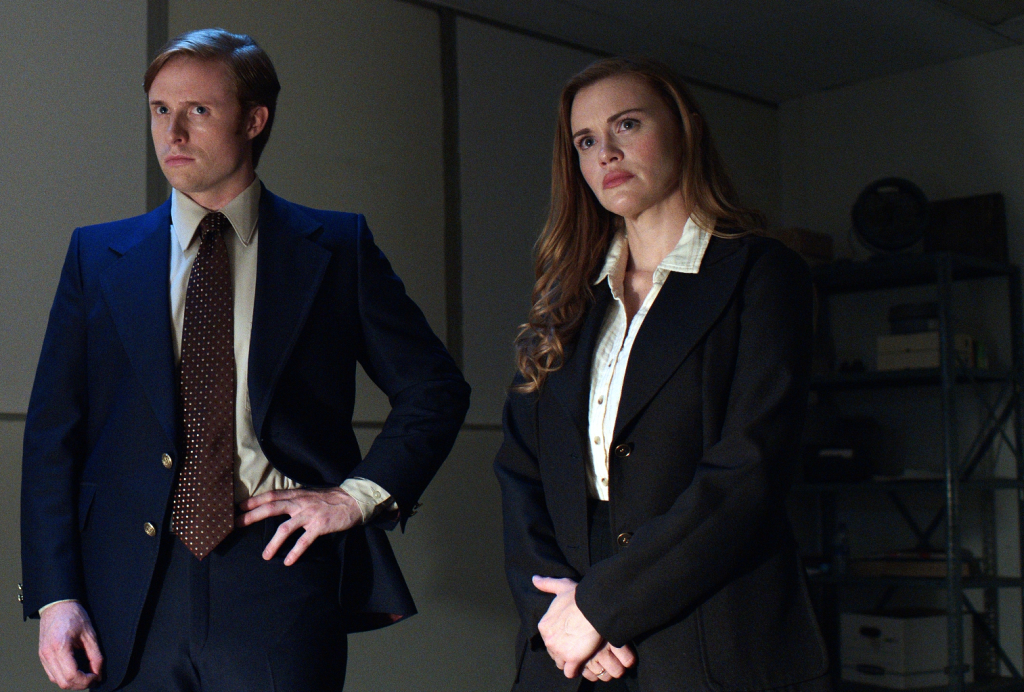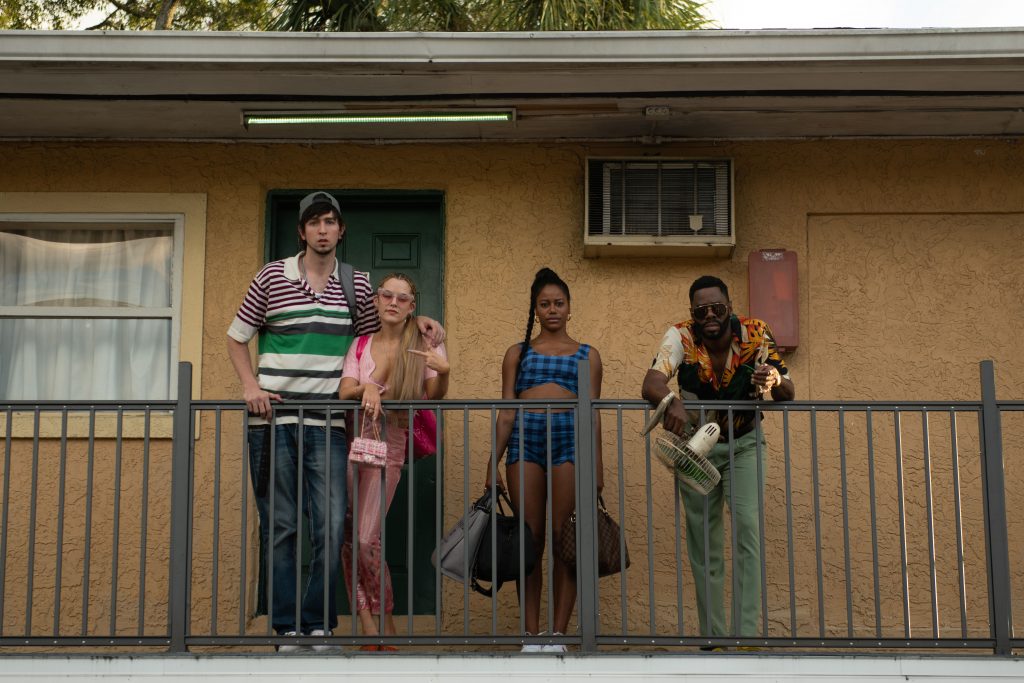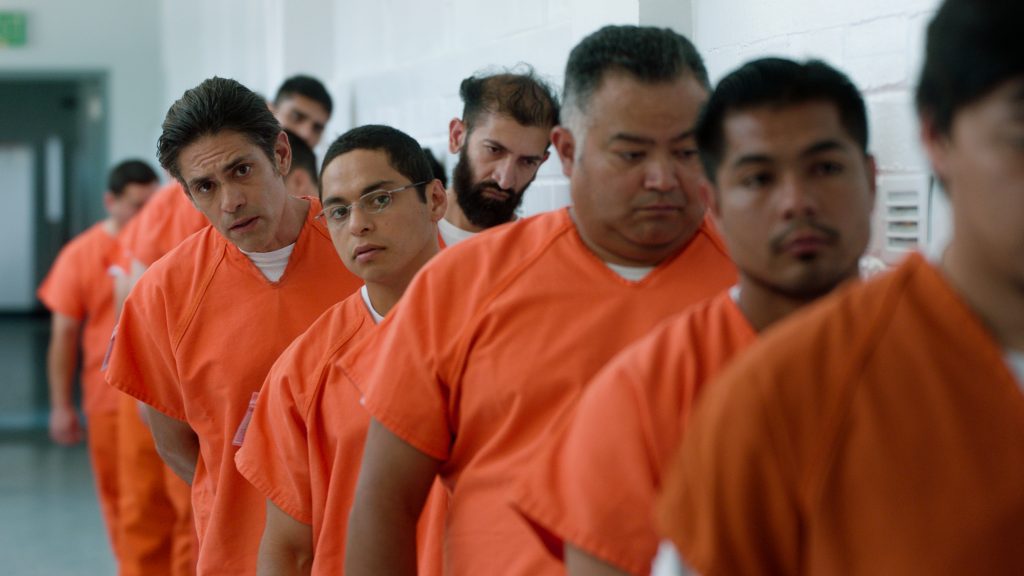July 5, 2024
by Carla Hay

Directed by Greg Berlanti
Culture Representation: Taking place in 1969, in Florida and briefly in New York and Louisiana, the comedy/drama film “Fly Me to the Moon” features a predominantly white cast of characters (with a few African Americans) representing the working-class, middle-class and wealthy.
Culture Clash: An ambitious advertising executive and a patriotic NASA flight director have conflicts over how to handle marketing and media coverage of the historic Apollo 11 spaceflight that was the first to send people to the moon.
Culture Audience: “Fly Me to the Moon” will appeal primarily to people who are fans of stars Scarlett Johansson, Channing Tatum, movies about NASA, and dramedies that present revisionist versions of real history.

“Fly Me to the Moon” is a breezy and charming comedy/drama that tells an alternate and often-satirical version of planning media coverage of NASA’s historic Apollo 11 spaceflight. Scarlett Johansson and Channing Tatum carry this movie over some of its bumpier parts. It’s the type of movie that will have the most appeal with people who have good knowledge of American history (especially when it comes to NASA) and can appreciate movies that poke fun at how easily the media can be manipulated.
Directed by Greg Berlanti and written by Rose Gilroy, “Fly Me to the Moon” is based on a story by Bill Kirstein and Keenan Flynn. The movie takes place during an untold number of weeks leading up to and including July 20, 1969, the date that the Apollo 11 spaceflight put the first people on the moon. The movie has a little bit of something for everyone: scientific adventure, emotional drama, suspenseful thrills, lighthearted comedy and entertaining romance.
“Fly Me to the Moon” begins with a voiceover from a character who is later introduced as Moe Berkus (played by Woody Harrelson), who says he works in the office of the U.S. president. (Richard Nixon was president of the U.S. at the time. And although his name is mentioned a few times in the movie, he’s not a character in the film.) Moe is a government official who acts more like a spy than someone who has a typical administrative job.
An opening montage sequence explains how the Space Race competition between the Untied States and Russia (which was then known as the U.S.S.R.) heated up in the 1960s, as both countries competed to be the first to send people to the moon. In a 1962 speech at Rice University, then-U.S. President John F. Kennedy stated that the U.S. would accomplish this goal before the end of the 1960s.
In 1969, Cole Davis (played by Tatum), a bachelor with no children, is NASA’s launch director at Kennedy Space Center on Merritt Island, Florida. He is confident and has the respect of his team. It’s later revealed that Cole is a Vietnam War veteran who used to be a military pilot. He had trained to be a NASA astronaut but had to leave the astronaut training program when it was discovered that his heart had a fibroid. Cole also has some emotional baggage, including remorse and guilt, over his involvement in the tragic Apollo 1 spaceflight where three astronauts died.
Kelly Jones (played by Johansson), a bachelorette with no children, is also an assertive achiever who sees herself as highly motivated. She works for a New York City-based advertising agency called Hoover. Kelly knows she’s in a male-dominated profession, so she uses her wit and charm to impress people who underestimate her. An early scene in the movie shows Kelly (who’s wearing a fake baby bump to appear pregnant) astounding an all-male group of executives working for a car company client during a conference room meeting. She tells all of the executives in the meeting what types of cars they drive and what types of cars they should be driving.
These weren’t lucky guesses from Kelly. She did her homework in researching these executives. An unethical reason for her success in business is that she has a long history of presenting fake stories, images situations as being real. More of Kelly’s past is revealed in the story. Why did she fake a pregnancy in a business meeting? It’s an example of how far Kelly is willing to go to manipulate people into thinking that she’s more vulnerable than she really is, in order to get what she wants.
Someone who has noticed Kelly’s “smoke and mirrors” skills is Moe, who can be either stern and smirking in the way that he interacts with people. He approaches Kelly in a bar, introduces himself as someone who works for the U.S. president, and shows her proof that he knows a lot of secrets from her past, including Kelly having a history of creating false identities for herself. Moe tells Kelly that he can make her shady past go away if she takes NASA as a client to market the Apollo 11 spaceflight to the public.
Moe explains that Apollo 11 has a public relations crisis because many people, including several influential politicians, think that the U.S. government is spending too much money to try to send people to the moon. At the time, sending people to the moon was still considered an improbable science fiction fantasy. Kelly’s job would be to “sell” Apollo 11 as not only patriotic but also an opportunity for capitalists to make a lot of money. Kelly feels she has no choice but to take this job, and she sees it as a challenge that she can conquer.
And so, Kelly goes to Kennedy Space Center with her trusted assistant Ruby Martin (played by Anna Garcia), who is openly a liberal feminist. Ruby says she has a problem with the job if it means they’re working for politically conservative Richard Nixon, but Kelly assures Ruby that their client is really NASA. The budget for this job is much lower than what Kelly usally gets. She and Ruby have to stay at a motel. And to their dismay, their office at NASA is cluttered and small.
Soon after arriving in Florida, Kelly is by herself in a diner when Cole walks in and looks at her as if he’s immediately attracted to her. Kelly notices Cole staring and her, and they both try to play it cool. He finally approaches her.
They have their “meet cute” moment when he notices that a candle on her table has accidentally lit a book on fire. Cole quickly puts out the fire, and she offers to buy him a drink. He tells her that he doesn’t drink alcohol. Later, it’s revealed that Cole is also very religious. In other words, Cole and Kelly have opposite lifestyles.
Kelly notices that Cole is wearing a NASA pin. They have some casually flirtatious conversation where she plays coy about who she is and exactly what she’s doing in this part of Florida. Before Cole leaves, he is somewhat bashful and a little awkward when he tells her that she’s the most beautiful woman he’s ever seen. Cole thinks he’ll probably never see her again, but there would be no “Fly Me to the Moon” movie if this was just a one-time encounter between Cole and Kelly.
Cole inevitably finds out who Kelly is and what she’s doing at Kennedy Space Center. When they see each other again, she’s giving orders on his turf. And he doesn’t like it one bit. When two people who are accustomed to getting their own way have to work together and disagree, arguments and other conflicts predictably ensue. And when those two people have sexual tension with each other, the conflicts get even more complicated and personal.
“Fly Me to the Moon” takes a while before it gets the parts of the movie that are the most interesting. A lot of screen time is taken up by somewhat repetitive scenes of Cole disliking almost every idea that Kelly has in order for her to make the Apollo 11 spaceflight more appealing to skeptics. Soon after finding out that he has to work with Kelly, Cole tells her to forget about what he told her about how he thinks she’s the most beautiful woman he’s ever seen because he wants their relationship to be strictly platonic. (And we all know that’s a lie because they’re obviously attracted to each other)
Kelly’s ideas involve things such as product placement and marketing the Apollo 11 astronauts as product spokespeople; hiring actors to pretend to be NASA officials (including Cole) who don’t want to do media interviews; and creating fake personal histories about herself, in order to make herself more relatable to politically conservative U.S. Senators whose votes are needed to get more funding for Apollo 11. In very unrealistic-looking scenes, Kelly suddenly acts like a political lobbyist and has separate meetings with U.S. Senator Hopp from Georgia (played by Gene Jones) and U.S. Senator Cook from South Carolina (played by Colin Jost, who’s married in real life to Johansson). And then, Cole gets in on the lobbying too when he and Kelly have dinner with Senator Vanning from Louisiana (played by Joe Chrest) and his wife Jolene Vanning (played by Stephanie Kurtzuba) in the Vanning family home.
Some of the other NASA people at Kennedy Space Center who work closely with Cole include executive launch director Henry Smalls (played by Ray Romano) and two engineers in their 20s: resourceful Stu Bryce (played by Donald Elise Watkins) and nerdy Don Harper (played by Noah Robbins), who becomes Ruby’s love interest. The three Apollo 11 astronauts—Neil Armstrong (played by Nick Dillenburg), Buzz Aldrin (played by Colin Woodell) and Michael Collins (played by Christian Zuber)—are given somewhat generic personalities and are not the focus of the story. There’s also a stray black cat hanging out at Kennedy Space Center, much to the annoyance of Cole, who doesn’t like this cat because he thinks the cat is bad luck.
Moe isn’t at Kennedy Space Center all the time to see how Kelly is doing her job, but he has ways of monitoring what she’s doing. He orders her to do something that is highly unethical, which is already revealed in the “Fly Me to the Moon” trailers: Film an alternative version of the Apollo 11 moon landing where everything goes perfectly, and pretend that this recording is a live telecast of the real moon landing.
Moe has a name for this massive lie about Apollo 11: He calls it Project Artemis. Moe pressures a reluctant Kelly to carry out this scam because he says it’s a matter of national security. “This isn’t just a race for the moon,” Moe says in a lecturing tone to Kelly. “This is a race for the ideology that gets to run things.”
Kelly recruits her longtime director colleague Lance Vespertine (played by Jim Rash) to be a part of the scheme. Lance, who is a very fussy and flamboyant prima donna, directs commercials (he has the nickname “the [Stanley] Kubrick of commercials”), but he really wants to direct prestigious movies. Rash is a hilarious scene stealer and gets some of the best lines in the movie, although some viewers might find the Lance character kind of irritating.
When it comes to recreating 1969, “Fly Me to the Moon” is at its best with the movie’s production design, costume design, makeup and hairstyling. Some of the dialogue and mannerisms aren’t quite convincing because they seem too influenced by later decades. Tatum in particular has some scenes where he comes across as too 21st century. (And there are some sleek, lingering shots of him staring into the distance as if he’s in a fashion ad.)
Johansson (who is one of the producers of this movie) is more believable as a retro character who is living on the cusp of the women’s liberation movement of the 1970s. Kelly often blurs the lines between being a coquettish sex symbol and being fiercely independent feminist. Some of the scenarios in the movie go a little overboard in making it look like Kelly can get anyone to do anything she wants just because she’s a beautiful blonde.
Tatum and Johansson together have crackling chemistry in their scenes together. Cole and Kelly don’t really seem like soul mates because a lot of their attraction to each other has to do with their physical looks and the way they like to compete with each other. For most of the movie Cole doesn’t ask Kelly very much about herself because he’s too busy arguing with her and trying to assert his authority. Kelly has many secrets and has no qualms about being a habitual liar, so it’s questionable if she’s capable of having a truly honest relationship.
All of those questions are put on the back burner when the last third of the movie takes a “race against time” turn concerning the big fraudulent Project Artemis plan that Moe wants Kelly to carry out on behalf of the U.S. government. Kelly is also ordered to keep this scheme a secret from almost everyone at NASA, including Cole. “Fly Me to the Moon” has a heightened sense of glossy movie glamour that shows it’s not intended to be a historically accurate movie. It’s pure escapist fantasy that mixes some parts of real-life history with fictional main characters and 1960s nostalgia. It all results in an entertaining movie experience whose best moments outshine any flaws.
Apple Original Films and Columbia Pictures will release “Fly Me to the Moon” in U.S. cinemas on July 12, 2024. Sneak previews of the movie took place in U.S. cinemas on July 1 and July 5, 2024.







